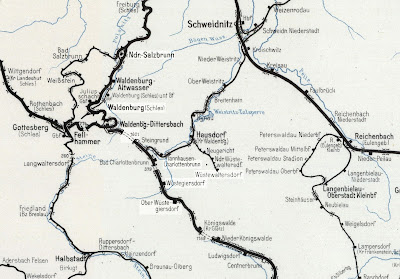...And this is how my children remember the scene, from Britt Allcroft's 1984 TV adaptation of the series. Faithful to the original concept.
Or the search for Duke the Lost Engine, published in 1970, illustrated by Gunvor and Peter Edwards (below)? "Years passed. Winter torrents washed soil from the hills... Trees and bushes grew around. You wouldn't have known a[n]...engine was there."
Well, Henry was extracted from the tunnel, to go on and enjoy a famous career as a Really Useful Engine - while Duke the Lost Engine was found by a group of determined enthusiasts and restored to his former glory. Ahhh... If only that great mystical philosopher, the Rev. W. Awdry, were alive today... My brother postulates this.
So - what's new today? The search has moved on to Kilometre 61, further on up the line towards Wrocław than the previous hot location, Kilometre 65. It is the British press - in particular the Daily Mail's Ed Wight and the Daily Telegraph's Matthew Day and Gregory Walton - who're doing the digging on the story, while the Polish media (with the exception of TVN) is happy to sit back and wait, without engaging readers' or viewers' emotions.
I have some reservations - this photo (below), on the Mail's website, captioned "This family lived in a house overlooking the entrance to the tunnel. Slowikowski claims they were all killed on May 5, 1945, by the Nazis just days before the Soviets marched in. Rail workers suspected it was to keep them quiet". Yet the car to the left of the image is a Skoda 1201 Kombi estate, which did not enter production until 1952.
So - let's move to Kilometre 61 and see where the possible location no. 3 is... The fine green line demarcates Wałbrzych's city limits, so if the tunnel's here, it would also fulfil the condition of falling under the responsibility of the city's mayor.
I'm assuming the tunnel would be to the west of the Wrocław-Wałbrzych main line, because of the curve of the track and the steeply rising hillside.
It's around here that a forest fire broke out yesterday, and was quickly brought under control. Visitors from all over the world are gathering - should the gold train be discovered soon, Wałbrzych will be one hell of a place be be!
Meanwhile the Polish state in all its glory continues to get its knickers in a twist over the issue. Who's in charge? The army? The Lower Silesian Voivodship's Marshal's office - or the Voivode's office? Or the Ministry of Culture and National Heritage? Or the Mayor of Wałbrzych? Or the State Forests? Or the Służba Ochrony Kolei? Or the police? Or all supervised by the Council of Ministers? A crisis HQ has been set up - I bet that its first meeting must have been interesting, as all the above slug it out for supremacy.
In the hills above Wałbrzych, the authorities are trying to keep amateur treasure hunters at bay, while the Sztab Kryzysowy decides on a course of action.
This story will not go away until the location shown on ground-penetrating radar by the deputy culture minister is explored. If it's shown (again) to be empty of trains (carrying gold or otherwise) - fine - the exploration must have been seen by the world's media as having been undertaken in a thorough way, following good practice from beginning to end. This may be the outcome. Yet if a train is found, the lengths that have been taken to hide it suggest that it's unlikely to be just a regular armoured train carrying nothing but artillery and anti-aircraft guns. We wait - this story is just fabulous. In the literal sense of the word.
[Links to Part I here and II of the story here.]
This time last year:
Changes to Poland's road traffic laws
This time two years ago:
Poland post the Rubbish Revolution
This time three years ago:
Poland's most beautiful street
This time four years ago:
Getting to grips with phrasal verbs
This time six years ago:
What Putin wrote about Molotov-Ribbentrop
This time seven years ago:
Summer Sunday in the city
This time eight years ago:
Last bike-ride to work of the summer




















































